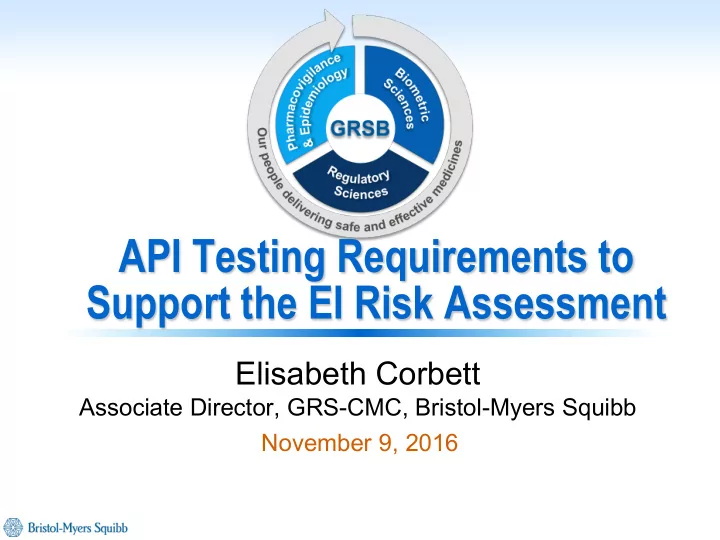

API Testing Requirements to Support the EI Risk Assessment Elisabeth Corbett Associate Director, GRS-CMC, Bristol-Myers Squibb November 9, 2016
Agenda Background Review of ICH Q3D Risk Assessment Principles Challenges associated with API implementation The API Risk Assessment (RA) for EI Constructing the initial assessment Conducting testing and assessing data Considering the additional RA factors – Starting materials – Equipment and Container Closure Implementation across a Portfolio Driving consistency and Documenting Strategy 2
Background Review of ICH Q3D Risk Assessment Principles What is a Risk Assessment? Per ICH Q3D: – “A systematic process of organizing information to support a risk decision to be made within a risk management process.” Per ICH Q9: – “Three fundamental questions are often helpful: 1. What might go wrong? 2. What is the likelihood (probability) it will go wrong? 3. What are the consequences (severity)? 3
Background Review of ICH Q3D Risk Assessment Principles Components of the ICH Q3D Risk Assessment: The Fishbone Diagram: – API and Excipients considered most likely sources for EI contamination for most dosage forms – Diagram starts with API, but there are components that need to be assessed for contribution to overall risk Container Closure Equipment Exposure Starting Materials and Reagents 4
Background Challenges Associated with Implementation Implementation: If the risk assessment is: What kind and how much – “A systematic process of information is considered organizing information to adequate? support a risk decision to be made within a risk management process.” How much and what kind of information is needed If the assessment starts to assess these factors? with API: Container Closure Equipment Exposure Starting Materials and Reagents 5
The API Risk Assessment Constructing the Initial Risk Assessment When? Preparation should begin prior to definition of acceptance criteria for drug substance intended for clinical studies How? 1- Analysis of the Synthetic Route: Assess route for intentionally added EIs and EIs known to be introduced by starting materials 2- Outline of Testing Strategy for Development Lots: Route of Class Class Class Class Intentionally Administration 1 2A 2B 3 Added Oral x x x Parenteral x x x x 6
The API Risk Assessment Conducting Testing and Collating Data Conducting Testing Collection of general (non-intentional metal) data to support the risk assessment should begin in development with qualified methods – “Should possess characteristics… such the manufacturer can be reasonably certain… the measurements can be relied upon to decided whether to include routine testing… in the control strategy” 1 Collection of data to support removal of intentionally added metals to acceptable levels (e.g. < 30% of PDE remaining) should begin in development using specific method – Specification may be needed for clinical supplies 1 Elemental Impurities in Drug Products , DRAFT Guidance for Industry, FDA, June 2016. 7
The API Risk Assessment Conducting Testing and Assessing Data Assessing Data Determine Control Strategy from LTSS to the Marketing Application – Continue monitoring as per the development plan – Assess development and pilot data • Determine whether process control or routine testing is appropriate Demonstrate the absence of EI: “Show with convincing evidence that it is purged to a level which is Minimum 3 commercial consistently below 30% of the batches OR 6 pilot batches calculated concentration limit based on intended route of administration” 1 Implementation of ICH Q3D in the Certification Procedure , EDQM, August 2016. 8
The API Risk Assessment Considering the Additional RA Factors Starting Materials Are EIs introduced via SM synthetic route? – No: Screen 3 lots of vendor material to demonstrate absence of EI Is there a supplier specification already in place for intentional EIs? – No: Calculate max allowable to remain below threshold in API and determine whether a spec is needed based on screening of 3 vendor lots – Yes: Calculate max contribution in API at spec and determine if adequate or if an internal or lower vendor spec is needed Could other metals serve as alternative to the intentional EI? – Yes: Screen lots for these EIs in addition to that of current route 9
The API Risk Assessment Considering the Additional RA Factors Starting Materials (cont.’) What if the vendor makes changes? – Quality agreements and change control address- not necessarily more testing! What if the vendor introduces new EIs into facility in other syntheses? – Qualified suppliers should be assessed as having adequate GMPs and cleaning procedures in place 1. What might go wrong? 2. What is the likelihood it will go wrong? 3. What are the consequences? 10
The API Risk Assessment Considering the Additional RA Factors Equipment and Container Closure Equipment- Low Risk – Screening for class 1 elements and additional known EIs from stainless (Ni, V and Co) throughout development (see ICH Q3D Case Study 1A) – Combination of screening information and quality system procedures in place (see ICH Q3D Case Study 2) – Biologics may need to consider possible EI contribution more thoroughly Container Closure- No Risk – Solid API offers no mechanism for transfer of EI from storage container 11
Implementation Across a Portfolio Driving Consistency and Documenting Strategy Ideal State Harmonized approach to implementation across teams Risk assessments developed early in program Consistent approach with suppliers Getting to the Ideal State… Centralized committee charged with: Providing training and background on the guideline Working with individual development program teams to : Construct initial EI strategy/approach for API Assess the EI risk associated with raw materials and intermediates Implement the appropriate testing strategy with suppliers Provide guidance/responses in the event of regulatory questions 12
13
Recommend
More recommend